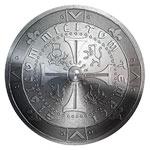The Measure of Alchemy. Celtic Alchemy or the Art of coordinating the Six Rays

One of the basic principles of alchemy as a science is to collect, unite and connect all the parts of a universal knowledge. In this regard the heritage of the Celts is exceptionally valuable, since it demonstrates before the world the value of the systematic knowledge of alchemy as a global, unifying and synthesizing science, that collects and creates something new. Celtic Alchemy is a phenomenon that exceeds cultural boundaries, it brings together the religious, educational, historical and cultural heritage of many peoples.
Celts created a unique approach to understanding the world based on the principle of acting. In fact, they laid the foundation for what became known as alchemy in the Arabic and European traditions. If we take into account that the Celts were associated with Taoism, we can even claim that there is a certain common format of alchemy uniting the Asian, Arab and European branches.
The formation and development of Celtic alchemy holds a special place in human history. Iberians, Ligures, Picts, pre-aryans, Aryans, Belgae, Britons, Illyrians and even Hyperboreans, the fabulous people of Atlantis ... This is even not a complete list of the ancient peoples and cultures that influenced the formation of the Celtic tradition!
Probably, no other world culture has absorbed such an amount of knowledge as the Celtic. Constantly migrating and intersecting with different peoples, the Celts developed such principles that subsequently determined the nature of Celtic Alchemy as the science of proportion, rhythm and filling. This doctrine is also called The Science of the Six Ray.
The Science of the Six Rays is the doctrine of the development of all living things. Layering the water molecules - as we would say today - was the most interesting knowledge for the ancient Celts. They came to understand that the model of water was complete in itself. Therefore, the ability to layer was seen as the ability to get a new, more complex model which - when implanted in the body - could replace the existing model.
This is done in a certain state of tension, when the molecule does not behave the way it does when at rest. In other words, a new embryo with a certain concentration of water molecules is created. These molecules should be six in total (all divergent). Thus a new force is born, as well as the ability to absorb more complex elements, such as crystals.
The creation of hexagonal forms facilitates the achievement of maximum change, which is, in fact, the task of Celtic Alchemy. This leads to a change similar to the formation of steam when the physical becomes volatile.
We need to learn to extract the body beyond the limits of circumstance. The Celtic culture is essentially an attempt to cross beyond this border state. Like a good cocktail, the Celtic tradition has incorporated a set of the best ingredients and is, thus, in its essence alchemical.
Who is the successor of the Celtic traditions today? Bretons, Welsh, the residents of the English county of Cornwall, the Scots, the Irish, the Manx or someone else? It is hardly possible to answer such a question, however we can clearly claim that the Celts are a certain collected, mixed phenomenon that has had a significant impact on the development of the whole of European culture. Moreover, we can accept the Templars - who were not based on knowledge, but rather on the construction scheme of knowledge - as the custodians of the knowledge of the Celts that was transformed and embodied in various forms: from the legends of King Arthur to Tolkien and even Harry Potter.
01 february 2013


